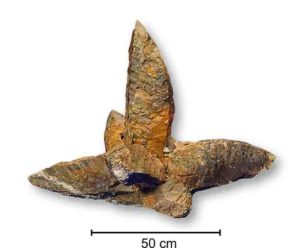
Researchers have long been stumped for an explanation of how tens of millions of years-old giant crystals known as glendonites came to be on the Danish islands of Fur and Mors. A recent study from the University of Copenhagen offers a possible explanation to the conundrum: major volcanic eruptions resulted in episodes of much cooler prehistoric climates than once thought.
Some of the world’s largest specimens of rare calcium carbonate crystals, known as glendonites, are found in Denmark.
The crystals were formed between 56 and 54 million years ago, during a period that is known to have had some of the highest temperatures in Earth’s geologic history. Their presence has long stirred wonder among researchers the world over.
“Why we find glendonites from a hot period, when temperatures averaged above 35 degrees, has long been a mystery. It shouldn’t be possible,” explains Nicolas Thibault, an associate professor at the University of Copenhagen’s Department of Geosciences and Natural Resource Management.
This is because glendonites are composed of ikaite, a mineral that is only stable, and can therefore only crystallize, at temperatures of less than four degrees Celsius.
Volcanoes responsible for cold intervals
In their new study, Nicolas Thibault, along with department colleagues Madeleine Vickers, Christian Bjerrum and Christoph Korte, performed chemical analyses of the Danish glendonites.
Their work reveals that the early Eocene Epoch, between 56 and 48 million years ago, was not at all as uniformly warm as once thought.
“Our study proves that there must have been periods of cold during the Eocene Epoch. Otherwise, these crystals couldn’t exist—they would have simply melted. We also propose a suggestion for how this cooling might have happened, and in doing so, potentially solve the mystery of how glendonites in Denmark and the rest of the world came to be,” says Nicolas Thibault. He adds:
“There were probably a large number of volcanic eruptions in Greenland, Iceland and Ireland during this period. These released sulphuric acid droplets into the stratosphere, which could have remained there for years, shading the planet from the sun and reflecting sunlight away. This helps to explain how regionally cold areas were possible, which is what affected the climate in early Eocene Denmark.”
Layers of volcanic ash in rock
The presence of volcanic activity is revealed by, among other things, sedimentary layers visible on Fur, where layers of volcanic ash are clearly visible as bands in the coastal bluffs.
“Our study helps solve a mystery about glendonites, as well as demonstrating that cooler episodes are possible during otherwise warmer climates. The same can be said for today, as we wise up to the possibility of abrupt climate change,” concludes Nicolas Thibault.
Reference:
Madeleine L. Vickers et al, Cold spells in the Nordic Seas during the early Eocene Greenhouse, Nature Communications (2020). DOI: 10.1038/s41467-020-18558-7
Note: The above post is reprinted from materials provided by University of Copenhagen.










